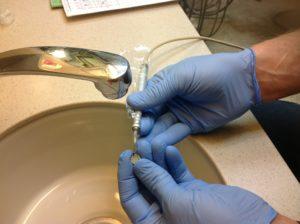 What do you call a technique that uses the principles of sandblasting to stream microscopic (27 or 50 microns) sand particles on a tooth or dental material to remove decay, glossy enamel or slick, non-adhesive surfaces of dental materials?
What do you call a technique that uses the principles of sandblasting to stream microscopic (27 or 50 microns) sand particles on a tooth or dental material to remove decay, glossy enamel or slick, non-adhesive surfaces of dental materials?
Microscopic air abrasion.
What can be used during dental treatment that produces no heat, no drilling sound, no pressure, no vibration and leaves no taste?
Microscopic air abrasion.
What’s the most conservative and effective way to prepare a tooth for a composite filling? (Since our office is mercury-free and mercury-safe, I haven’t placed a “silver” amalgam filling since 1984.)
Microscopic air abrasion.
What helps you visualize the area of decay while you’re preparing the tooth?
Microscopic air abrasion. (It’s a bit like power-washing a driveway rather than scrubbing it down and rinsing to see if it is clean enough)
 How do you safely minimize – even eliminate – the problem of causing microfractures when you prepare teeth for restorations?
How do you safely minimize – even eliminate – the problem of causing microfractures when you prepare teeth for restorations?
Microscopic air abrasion. (When drilling is necessary, I use half the normal handpiece speed.)
How do you maximize bond strength for the restorations you place?
Microscopic air abrasion. (Not mandatory but indisputably effective!)
Why doesn’t every dentist use this technology that you’ve been using every day for more than 25 years?
It’s messy. It’s best used with a dental dam. It requires protecting patients by covering their eyes with protective lenses. So what? We already protect our patients that way!
What technique do you use that tops the list for “minimally invasive dentistry”?
Microscopic air abrasion.